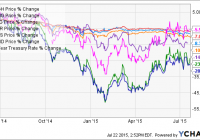Rate Hike Fears Rise, Time For Taper ETF?
The moment the China-induced stock market gyrations cooled a bit, the U.S. market started gaining ground. Meanwhile, the U.S. economy grew at 3.7% in Q2, which breezed past the initial reading of 2.3% growth and 0.6% expansion recorded in the seasonally weak Q1. Other data points including housing and job came on the stronger side at the home front. As a result, the bet on a September timeline of the Fed lift-off – which took a backseat in mid-August as global market rout took an upper hand – is back on the table on now. If this was not enough, Stanley Fischer who happens to be the Fed’s vice-Chairman flared up the rising rate worries even more. So, inflation was the main hindrance en route to Fed policy tightening as inflation is short of the Fed’s longer-term target on extremely muted energy prices. Also, the emerging Chinese market volatility prompted some to hope for a later-than-expected hike in rates. But, the Fed’s vice chairman expects inflation to inch up eventually. So waiting for a 2% inflation goal could be a pricey option. Though he added “we’ve got time to wait and see the incoming data and see what is going on now in the economy” before deciding on hiking rates, the jittery nerves ignited the rate hike bet all over again. There will be a set of data to be released and looked at before this historic decision is taken after nine long years, but the September lift-off timeline is now a possible option. This sent the yield on 10-year Treasury note to 2.20% (on September 2, 2015) from 2.01% recorded on August 24. In such a situation, the U.S. market will likely see a slump in the bond bull market next year and investors can make the most of it by shorting treasuries. Though the inverse U.S. Treasury space has only a handful of products, Barclays Inverse US Treasury Aggregate ETN (NASDAQ: TAPR ) could be an intriguing play for investors already preparing for the impending rate hike. TAPR in Focus The note provides investors a unique strategy to hedge against or benefit from the rising U.S. dollar interest rates by tracking the Barclays Inverse US Treasury Futures Aggregate Index. This benchmark employs a strategy, which follows the sum of the returns of the periodically rebalanced short positions in equal face values of each of the 2-year, 5-year, 10-year, long-bond and ultra-long U.S. Treasury futures contracts. If the price of each Treasury futures contract increases or decreases by 1% of its face value, the value of the index would decrease or increase by 5% over the same period. The ETN has about $22 million in net assets. It charges 43 bps in annual fees and trades in a light volume of about 5,000 shares per day on average, ensuring additional cost in the form of a wide bid/ask spread. The note added about 5.3% in last one month (as of September 2, 2015) thanks to the ascent of the benchmark treasury yield. Bottom Line TAPR offers investors positions against all five tenures on the U.S. Treasury futures curve and provides an interesting hedging strategy between short-term, intermediate-term and the long-term bonds. Investors should note that short-term bonds are less interest-rate sensitive and low yield in nature while long-term bonds act differently. Thus, focus on every part of the yield curve makes this product worthwhile. Original Post
